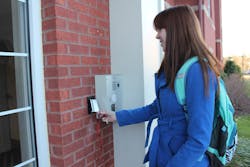In recent years, ensuring the safety and security of K-12 and higher education facilities across the country has become top priority, as school boards and administrators continue to seek better and more cost-effective ways to protect students, personnel, visitors and assets.
To accomplish this goal, many schools have chosen to install cameras and other devices to improve security. But while cameras have at times proven useful in reviewing and confirming what has happened, they have been much less successful at preventing incidents. On the other hand, access control, as its name suggests, literally controls access to the premises and can aid in preventing potential threats from entering a facility or campus. Far beyond cameras and video management systems, access control also helps track the comings and goings of school officials, teachers, students and visitors.
In addition to delivering superior access control, many of today’s advanced solutions can also keep track of students when they leave a class in session to visit the restroom, nurse’s office or any other internal or external area of the school. For example, a proximity device can be installed inside each classroom and at all entrances to the building or buildings. When students leave, they swipe a credential to register their time of departure. They are then given a predetermined amount of time to walk from the classroom to an approved destination, and if they fail to return within the allocated time period, the access control system will issue a general alert.
In an education setting, whether K-12 or university, different doors or types of doors require different levels of access privileges and/or unlocking schedules. Some doors that are kept open during the day are locked during evenings and weekends, but there may be instances when a teacher, administrator or staff member needs to access those areas during off hours. An advanced access control solution can ensure that access to each door is tailored to meet the needs of students, staff and visitors while providing optimal security. These systems enable administrators to activate individual ID cards to grant access only to the areas that are needed during specific times when access is needed. Once that timeframe has passed, special access privileges are revoked and the individual’s ID card returns to normal.
This capability also improves the convenience, efficiency and effectiveness of visitor access control. Whereas in the past, issuing temporary ID cards to visitors may have been a time-consuming manual process, today’s advanced access control software makes this much more effective and efficient. Administrators are able to create and program temporary ID cards quickly, often by simply checking or un-checking boxes on a computer screen to provide visitors with access to certain areas at a specific time, after which the card is deactivated.
Additionally, access control systems can be programmed to generate alarms and/or alerts when a door is propped open, whether during the school day or after hours, allowing administration to close the door and investigate and monitor the situation with the video surveillance system, which can be integrated with access control.
Beyond video, integration with human resources, visitor management, time and attendance and other systems allow today’s advanced access control solutions to extend their effectiveness beyond traditional security system models. This allows access control systems to be used to verify time and attendance for personnel, track access to equipment rooms and supply areas, track transportation arrivals and departures and more.
The advanced capabilities and integrations available in today’s access control systems give educational institutions from K-12 through higher education a tremendous advantage in meeting the challenges of safety and security. The added benefits of time savings, cost-effectiveness, smart technology and ease of use make it clear that when it comes to providing the level of proactive security necessary to help prevent threats and incidents, access control solutions are at the head of the class.
Robert Laughlin is President of Galaxy Control Systems. Request more info about the company by visiting www.securityinfowatch.com/10213742.
About the Author

Robert Laughlin
President, Galaxy Control Systems
Robert Laughlin is president of Galaxy Control Systems.
